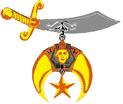| June 08, 2000
Cars, Hats and a Mission to Help Kids
You've seen them in just about every parade you can remember; men in
funny hats racing circles around each other in funny little cars. Maybe
you've seen them behind concession stands at the circus.
Who are these people? Why do they wear those funny hats? What do they
do when they're not making figure-eights with go-carts?
According to Shriner Parade Captain Gene Kelm, they're just ordinary
guys who value brotherhood and service.
Kelm, a Battle Lake resident who works in Fargo, is a member of the
Birak Kar Kor ("Birak" means "Land of Lakes" in Arabic) and of
Cornerstone Lodge #99 in Fergus Falls, one of the Masonic Lodges with
which the Birak Shrine Club is associated. Birak Shrine is officially
under the jurisdiction of the Zuhrah Temple in Minneapolis.
The Shriners have been around since 1872, when they arose as a
service fraternity within Freemasonry (the Masons), an even older
fraternity. The Birak Kar Kor was formed in 1986.
The Shrine's major focus is its
philanthropy. The organization sponsors twenty-two
Shriners Hospitals for Children around the country, including one in
Minneapolis. The hospitals admit children free of charge, and are funded
entirely through the Shrine. "It has never cost the patients any money,
and it never will" Kelm says, adding that the 22 hospitals operate on a
total budget of $2 million daily.
The Shriners raise money primarily through the circuses they organize
and also through smaller fund raisers. The parade appearances are for
publicity. "We want to be out there so people see us", Kelm says.
Members of the Shrine also make personal visits to the hospital,
which Kelm says makes all the effort worthwhile. "You wouldn't believe
it. It's not even like walking into a hospital," he says. "It's happy
and family-oriented. When you walk into the hospital and see a kid
smiling, that's what it's all about."
The hospitals, he says, are of the highest caliber; some of the top
surgeons in the U.S. practice there, and "they have the best facilities
and equipment that money can buy." |


![]() Kar
Kor 2005 Parade & Event Schedule
Kar
Kor 2005 Parade & Event Schedule